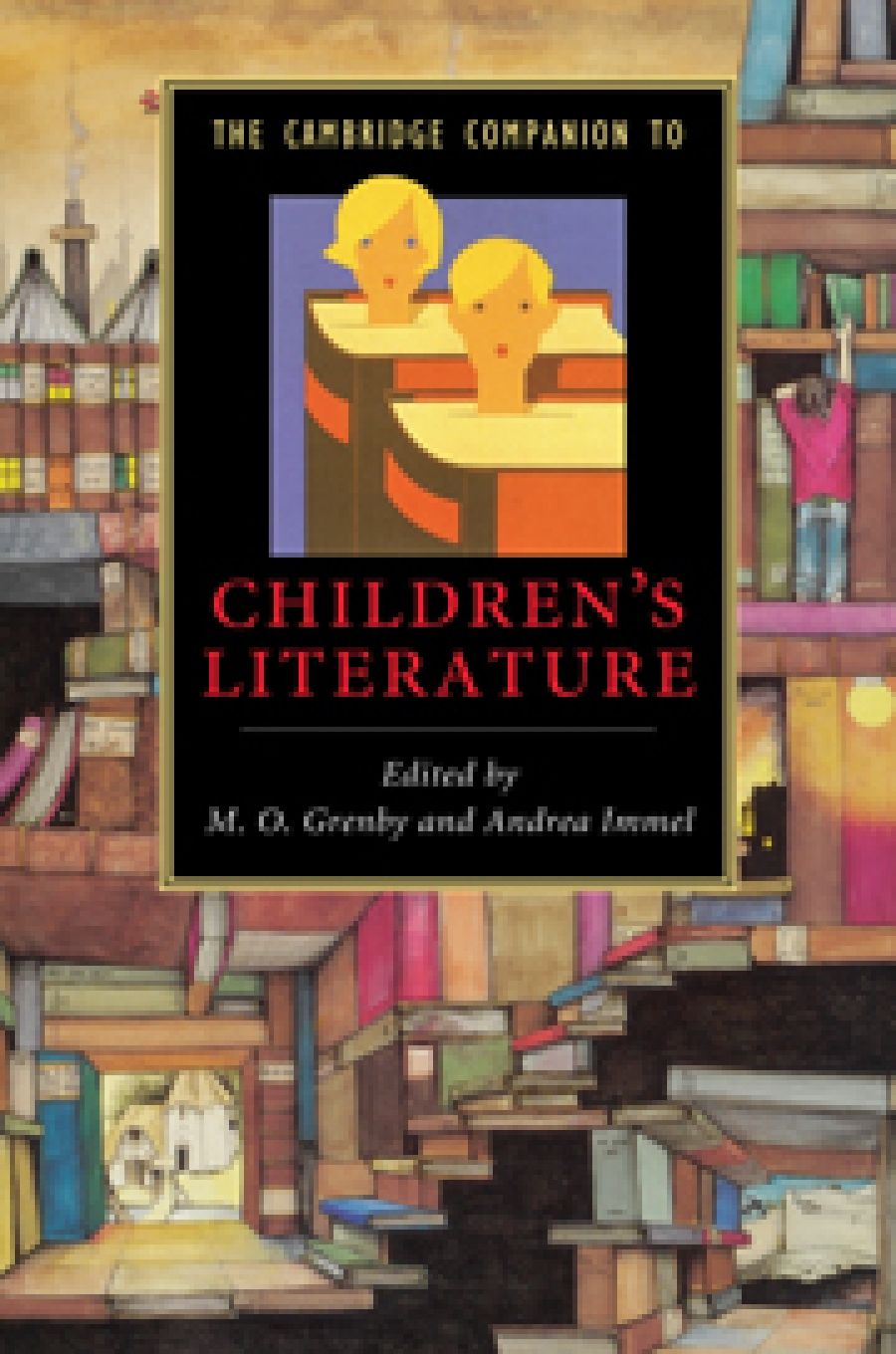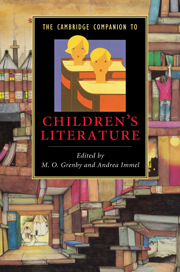
- Free Article: No
- Contents Category: Non-fiction
- Review Article: Yes
- Article Title: The whatabout game
- Online Only: No
- Custom Highlight Text:
Prepare to be affronted, or perhaps just a bit miffed. Although it does not confine itself to works by British writers, you will look in vain for Australian authors in the new Cambridge Companion to Children’s Literature. Among many titles from the United States, Little Women gets its due, as does Little House on the Prairie. Canada’s Anne of Green Gables is there, and so is Salman Rushdie’s Haroun and the Sea of Stories. Scan the index and you will find works of European origin, such as The Swiss Family Robinson and Johanna Spyri’s Heidi. The latter two, of course, could be given honorary citizenship because of their immense popularity in English translation.
- Book 1 Title: The Cambridge Companion to Children's Literature
- Book 1 Biblio: Cambridge University Press, $59.95 pb, 324 pp
- Book 1 Cover Small (400 x 600):

Before getting huffy with Cambridge, let’s look at The Oxford Companion to Children’s Literature (1984). That other place is much more hospitable to Australian writers. May Gibbs’s Snugglepot and Cuddlepie (1918) is there with the Banksia Men. Ruth Park’s Muddle-Headed Wombat (1962) has an entry, as do authors Ivan Southall, Colin Thiele, Wrightson and many others. So, what has happened to make Australia invisible to the Cambridge editors?
You could look at it another way and ask why Oxford took such an interest in Australian children’s books in 1984, and added an Australian volume to its reference shelf in 1993 (The Oxford Companion to Australian Children’s Literature, by Pam Macintyre and Stella Lees). One reason may be that in the 1950s and 1960s Oxford’s Australian branch was headed by Frank Eyre, an Englishman with a sharp eye for talent in this field. His discoveries – Nan Chauncy, Joan Phipson, Hesba Brinsmead and Eleanor Spence – appeared with the Oxford imprint and sold well in Britain. One anomaly, in a time of transition for Australian publishing, was that books by these Australian Oxford authors were printed and published in England; so that their Australian sales counted as ‘overseas’ and drew only half the royalty paid on their sales in Britain. This special, if uneven, relationship between Australia and Oxford University Press had no counterpart in Cambridge.
There are different ways of understanding companionship. The Oxford Companion’s editors, Humphrey Carpenter and Mari Prichard, used an alphabetical method for authors and titles, complemented by thematic essays, which include one on Australian children’s books. Their Companions move from ABC books to Charlotte Zolotow, mainly by author entries, but prominent titles and genres have places of their own. Some entries are blandly factual, but most give a sense of each work’s historical context, tone and implied readership. Even within the constraints of space of two thousand entries, there is room for quirky details. After Apple Pie’s description as ‘a traditional alphabet jingle which became a picture book by Kate Greenaway’ comes John Ruskin’s comment on Greenaway’s depiction of the letter R with two right feet.
Instead of the alphabetical reference book structure of the Oxford Companion, the Cambridge editors present a set of essays in which individual authors explore chosen themes, taking their texts more or less as they please, with no obligation to be inclusive. The editorial guidelines are ‘to confront the range and complexity’ of three centuries of children’s literature. The chosen focus is on imaginative literature published in Britain and America. This, the editors remark, brings its own limits.
Concentrating on these traditions, developed in tandem across the last three centuries, has imposed other limits by stealth. It has resulted in a bias towards books written for children who have been understood as highly individual, naturally playful, innocent and malleable, reflecting the dominant cultural construction of childhood in Britain and America since the mid-eighteenth century.
Given this model, one could argue about slippery terms such as ‘innocent’ and ‘malleable’ and suggest that Australian children have been seen in much the same way as those of Britain and the United States. Aren’t our children just as ‘naturally playful’ as your children? As in real life, some fictional children are more tough and knowing than ‘innocent and malleable’. Think of the boys in Robert Cormier’s The Chocolate War (1974), just for a start. But the editors have to draw a line somewhere; and it is convenient to set a geographical limit. I found one Australian title, which was perhaps accidentally included. Jenny Pausacker’s What Are Ya? (1987) is mentioned as an early exploration of lesbian identity within the school story tradition. I may have missed others, but the main point is that none of the best-known Australian writers makes an appearance.
So much for the parochial lament. Now, what does Cambridge offer? There are seventeen essays, contributed by six British, seven American, three Canadian and one Australian scholar (John Stephens, formerly of Macquarie University, Sydney). Stephens has no obligation to raise the local flag, nor does he. His engrossing essay, ‘Reading Stories across Time and Cultures’, looks at ways in which myths, Bible stories, folk and fairy tales are retold, often in parodic or iconoclastic ways.
Stephens discusses a multi-layered story by Terry Pratchett: The Amazing Maurice and his Educated Rodents (2001). This retelling of Browning’s The Pied Piper alludes to a diverse range of texts, historical persons and events. Dick Whittington becomes ‘Dick Livingston’, mayor of Ubergurgl, a reference to Ken Livingston, who was mayor of London when Pratchett’s book appeared. When Maurice the cat meets the dancing rat, Sardines, he thinks: ‘Of all the kitchens in the world he could turn up in he’s turned up in this one.’
This echo of a famous line spoken in Humphrey Bogart in Casablanca will not be picked up by the child audience of The Amazing Maurice, though it may amuse parents or (more likely) grandparents. It raises questions which are addressed by others in the Cambridge team: U.C. Knoepflmacher (‘Children’s Texts and the Grown-up Reader’) and Andrea Immel, who explores constructions of childhood through a Mrs X, out shopping for Christmas presents. Mrs X has no trouble finding the children’s section of the bookshop; the divide between adult and children’s reading is clear to everyone, as it is in libraries. But how to choose a book that will give pleasure? Should it be fun to read? And is fun the aim? At this point Mrs X falls into conversation with a bewildered elderly gentleman named John Locke. As she tries to guide him round the shelves, it becomes clear that Mr Locke’s concept of childhood is very different from that of Mrs X.
A Mrs X can judge the sort of book that parents will enjoy reading aloud. If it works on more than one level (with submerged jokes like Maurice the Cat as Humphrey Bogart), will the child feel left out when the adult is inexplicably amused?
The first section of the Cambridge Companion, ‘Contexts and Genres’, explores the ways in which children’s books create their separate world. Of these, I found ‘The Making of Children’s Books’ the most interesting. It focuses on matters of design and production; it reports on the sad fate of texts which fall out of copyright, and the ways in which new illustrations, especially in American editions of English books, change the meaning and responses to classic texts.
Sections Two and Three include essays on Audience, Forms and Themes. A few are disappointingly predictable and limited. Given the social changes brought about by the women’s movement in the late twentieth century, one would expect a more searching analysis of recent texts than appears in Judy Simon’s ‘Gender Roles in Children’s Fiction’. It begins with the ‘tomboy’, Enid Blyton’s George of the Famous Five, moves back to Ethel of The Daisy Chain (1856), Jo of Little Women (1868) and Katy of What Katy Did (1872). Simon finds no male equivalent of the tomboy, and suggests that boy heroes have not changed much. J.K. Rowling’s Hermione Granger, briefly mentioned, is one of the ‘brave, smart, resourceful girls’ who, nevertheless, are not allowed to upstage the male protagonist.
Written for scholars, teachers and some parents, the Cambridge Companion offers stimulating ideas, and its useful bibliography points the way to more. No Australian content? Such is life.

Comments powered by CComment